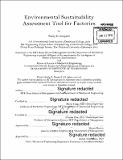Environmental sustainability assessment tool for factories
Author(s)
Koepsell, Emily Diane
DownloadFull printable version (7.260Mb)
Other Contributors
Leaders for Global Operations Program.
Advisor
Maria Yang and Charles Fine.
Terms of use
Metadata
Show full item recordAbstract
General interest and international regulations have begun to create a world in which consumers demand to know how their products are made and companies must provide that transparency. With over 15,000 suppliers, Li & Fung wants to obtain better insight into its suppliers' environmental sustainability characteristics. The Sustainable Apparel Coalition's (SAC) Higg Index is currently viewed as the foremost way to assess a supplier's environmental sustainability; however, its facility module only applies to certain types of industries. Li & Fung requires a tool that encompasses its full supplier base and is short and robust enough to provide valuable insight into its supply chain and help it engage factories in decreasing their environmental footprints. This thesis discusses the methodology used to create such a tool and the information acquired during a successful pilot. To facilitate integration and adoption, the categories and some of the questions and language are modeled after that in the Higg Index. However, this scorecard incorporates many different and more focused questions, and the majority of its answers are standardized to promote easy analysis post-assessment. Its scoring system is also quite robust, aiming to award points accurately and with attention to the information and quality of environmental initiative undertaken at a factory. Finally, it incorporates a novel benchmarking and visualization section, which not only will help the user compare factories, but also more clearly see the areas in which a given factory is excelling or needs improvement. This knowledge will then allow Li & Fung to engage with its suppliers and help them decrease their environmental impact. The scorecard was piloted in 14 factories in the Shenzhen, Shanghai, and Hong Kong regions. Factory types included categories such as apparel, home textiles, umbrellas, and bags. Benchmarking was done across factory types to investigate commonalities and compare initiatives.
Description
Thesis: S.M., Massachusetts Institute of Technology, Department of Mechanical Engineering, 2016. In conjunction with the Leaders for Global Operations Program at MIT. Thesis: M.B.A., Massachusetts Institute of Technology, Sloan School of Management, 2016. In conjunction with the Leaders for Global Operations Program at MIT. Cataloged from PDF version of thesis. Includes bibliographical references (pages 69-73).
Date issued
2016Department
Leaders for Global Operations Program at MIT; Massachusetts Institute of Technology. Department of Mechanical Engineering; Sloan School of ManagementPublisher
Massachusetts Institute of Technology
Keywords
Mechanical Engineering., Sloan School of Management., Leaders for Global Operations Program.